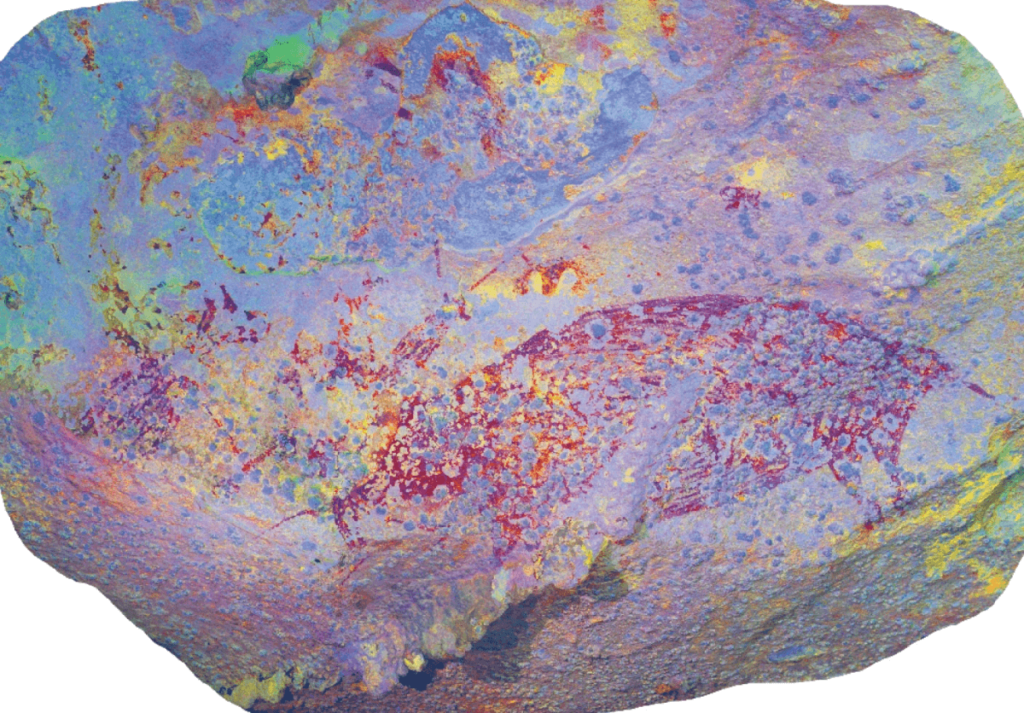
Panorama stitched together from photos of rock art panels (photos enhanced using DStretch_ac_lds_cb). (Credit: Nature/Griffith University)
QUEENSLAND, Australia — A tale of early humans hunting pigs around 50,000 years ago may be the first recorded story in human history. Discovered deep inside a limestone cave in Sulawesi, Indonesia, the remarkable cave art pushes back the origins of narrative art by thousands of years.
Australian researchers have discovered that our ancestors painted complex scenes of human and animal interaction at least 51,200 years ago, making them the world’s oldest examples of visual storytelling. The groundbreaking study focuses on two cave sites in the Maros-Pangkep region of South Sulawesi. Using advanced dating techniques, the researchers determined that the hunting scene in Reang Bulu Sipong 4 cave is at least 48,000 years old, while the newly discovered composition in Reang Karampuang cave is at least 51,200 years old.
“Our findings indicate that figurative depictions of anthropomorphic people and animals have deeper origins in the history of modern human (Homo sapiens) image-making than previously recognized, as do their representations in constructed scenes,” the study authors wrote in Nature.
Reang Karampuan’s work depicts at least three human-like figures interacting with a large pig, likely a Sulawesi warthog. The scene predates the next oldest known piece of narrative art by more than 20,000 years and fundamentally changes our understanding of the development of the early human brain and art.

 a, Panorama of stitched photographs of rock art panels (photos enhanced using DStretch_ac_lds_cb); b, Trace of rock art panel showing LA-U sequence dating; c, Trace of painted scene showing human-like figures (H1, H2, H3) interacting with a pig; d, Transverse section of coralline speleothem sample LK1 removed from rock art panel, showing the paint layers and three zones of integration (ROIs) and associated dating; e, LA-MC-ICP-MS imaging of LK1 232Th/238U isotope activity ratio. (Credit: Nature/Griffith University)
a, Panorama of stitched photographs of rock art panels (photos enhanced using DStretch_ac_lds_cb); b, Trace of rock art panel showing LA-U sequence dating; c, Trace of painted scene showing human-like figures (H1, H2, H3) interacting with a pig; d, Transverse section of coralline speleothem sample LK1 removed from rock art panel, showing the paint layers and three zones of integration (ROIs) and associated dating; e, LA-MC-ICP-MS imaging of LK1 232Th/238U isotope activity ratio. (Credit: Nature/Griffith University)
A new way to date ancient art
“The key to this discovery is the novel approach that the team took to dating the cave art. Previous studies have analysed calcium carbonate deposits that formed on top of the art using a method called uranium-series dating. While effective, this method has limitations when dealing with thin or complex mineral layers.
The researchers developed an innovative laser-based method that allowed for a more precise analysis: by using laser ablation to create a detailed map of the calcium carbonate layers, they were able to pinpoint the oldest deposits located directly above the pigments.
“This method allows for greater spatial precision and reveals older minimum dates for previously dated artworks,” the researchers explain.
The team used the technique to re-date the hunting scene at Leang Bleu Shipon 4, previously thought to be around 44,000 years old. The new analysis revealed that it is at least 48,000 years old — 4,000 years older than originally thought.
Tracing back the history of human art
Armed with this sophisticated dating method, the researchers turned their attention to the Leang Karampuang cave, where they discovered and dated a previously unknown composition depicting a human-like figure that appears to be interacting with a pig.
Three small figures are arranged around a much larger pig painted with red clay. Two of the figures appear to be holding something, possibly a spear or a rope, while the third is depicted upside down, with his arm extended towards the pig’s head.
The team used laser ablation techniques to date the calcium carbonate deposits on top of the statues, and the results were surprising: they found the artworks to be at least 51,200 years old, making them the oldest examples of narrative art in the world.
“While this enigmatic scene may represent a hunting tale, the prominent depiction of beast-like figures suggests that the artwork reflects an imagined narrative (e.g., a myth),” the international team wrote.
Rewriting the history of human creativity
These discoveries have profound implications for our understanding of the development of the ancient human brain. The oldest known figurative art is a painting of a warthog from the same region, Sulawesi, which dates back to 45,500 years ago. The oldest known narrative scene is thought to be a hunting scene from Leang Bulu Sipong 4, originally dated to 44,000 years ago.
This new date pushes back the origins of both representational and narrative art by thousands of years, suggesting that early humans in the region were engaged in complex symbolic thought and visual storytelling (drawing and painting) much earlier than previously thought.
“This suggests that a rich narrative culture developed early on in the long history of Homo sapiens in the region, in particular where landscape representations were used to tell visual stories about human-animal relationships,” the researchers wrote in Nature.
This research not only sheds light on the artistic talents of our ancestors, but also provides insight into their thought processes and social structures. The ability to create and understand narrative scenes in cave paintings implies complex language skills and abstract thinking abilities.
As scientists continue to unearth and analyze ancient art, timelines of human cultural and cognitive evolution may need to be revised: A Sulawesi cave reveals that our ancestors were skilled artists and storytellers tens of thousands of years earlier than we had imagined.


